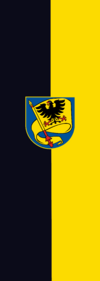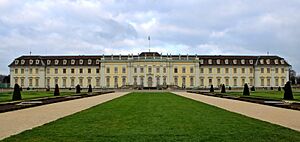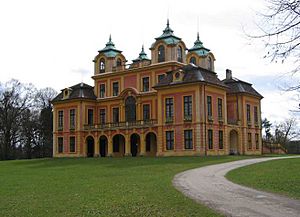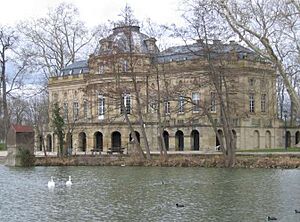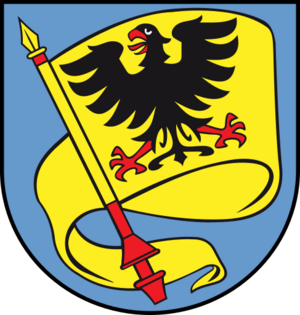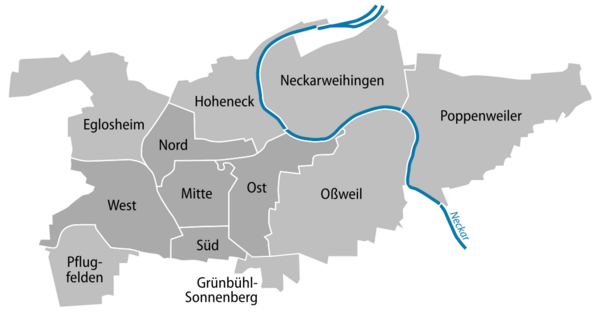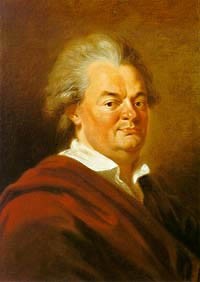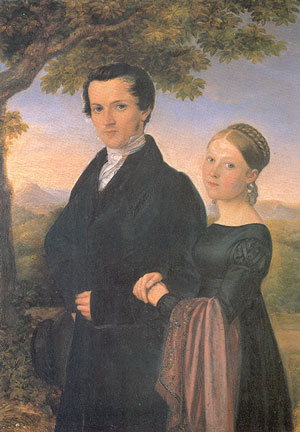Ludwigsburg facts for kids
Quick facts for kids
Ludwigsburg
Ludisburg (Swabian)
|
|||
|---|---|---|---|
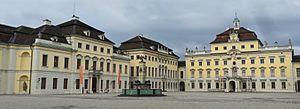
Ludwigsburg Palace, inner courtyard
|
|||
|
|||
| Country | Germany | ||
| State | Baden-Württemberg | ||
| Admin. region | Stuttgart | ||
| District | Ludwigsburg | ||
| Elevation | 293 m (961 ft) | ||
| Population
(2022-12-31)
|
|||
| • Total | 94,157 | ||
| Time zone | CET/CEST (UTC+1/+2) | ||
| Postal codes |
71634–71642
|
||
| Dialling codes | 07141 | ||
| Vehicle registration | LB | ||
| Website | www.ludwigsburg.de | ||
Ludwigsburg is a city in Baden-Württemberg, Germany. It is about 12 kilometers (7.5 miles) north of Stuttgart. The city is close to the Neckar River. Ludwigsburg is the biggest city in the Ludwigsburg district. About 94,000 people live there.
Contents
A Look at Ludwigsburg's Past
The area where Ludwigsburg is located has been settled for a very long time. People lived here during the Stone Age and Bronze Age. Many old sites from the Hallstatt culture can still be found.
Towards the end of the 1st century, the Romans took over this area. They controlled it until 260 AD. Then, the Alamanni people moved into the Neckarland region. We can find proof of the Alamanni living here in old grave sites.
How Ludwigsburg Started
Ludwigsburg began in the early 1700s. Duke Eberhard Ludwig, Duke of Württemberg started building Ludwigsburg Palace in 1704. This palace became one of the largest baroque castles in Germany. The Duke first planned only one country home. But he saw other rulers building grand cities. So, he wanted to show his own power by creating a new city.
He added a hunting lodge called Schloss Favorite (built 1713–1728). He also built a castle on the lake, Monrepos (built 1764–1768).
People started settling near the palace in 1709. Ludwigsburg officially became a town on April 3, 1718. That same year, it became an important local center. This area later became the Ludwigsburg district in 1938.
Between 1730 and 1800, the royal family sometimes lived in Stuttgart and sometimes in Ludwigsburg. In 1800, Napoleon Bonaparte's French army took over Württemberg. They forced the region into an alliance. In 1806, Napoleon made Friedrich, the Prince-Elector, the king of Württemberg. In 1812, soldiers from Württemberg were gathered in Ludwigsburg for Napoleon's war in Russia. Out of 15,800 soldiers, only a few hundred came back.
In 1921, Ludwigsburg became a major military base in southwest Germany. In 1945, it was made an "urban district." Later, in 1956, it became a "major urban district." Germany's army, the Bundeswehr, started using the military base again in 1956.
In 2004, Ludwigsburg Palace celebrated its 300th birthday. New art galleries and a ceramic museum opened there.
Building a New Capital
The area around Ludwigsburg was a favorite hunting spot for the royal family. In 1704, Duke Eberhard Louis started building Ludwigsburg Palace. The city is named after his middle name, Ludwig.
The Duke wanted to build a perfect Baroque city next to the palace. From 1709, he offered special deals to attract new people. He promised free land, free building materials, and 15 years without taxes. Later, he added freedom to choose one's job and religion.
The town really started to grow when it became a city in 1718. It also became the royal home and capital of Württemberg. By 1733, about 6,000 people lived there. This was more than half the size of the old capital, Stuttgart. Still, Ludwigsburg was a big construction site with many unfinished buildings.
Duke Eberhard Louis lived in Ludwigsburg with his mistress, Wilhilmine von Grävenitz. His wife, Duchess Johanna Elisabeth, stayed in Stuttgart. Wilhilmine was smart and ambitious. She influenced politics and gained power.
When it seemed the Duke's only son would not become ruler, Eberhard Louis changed his mind. He left his mistress and made up with his wife. He hoped to have another son. Many people were happy about this. They feared that a Catholic part of the royal family would take power. To celebrate, people in Ludwigsburg made a picture. It showed Ludwigsburg getting a pearl, a symbol of new life, from God. But the Duke did not have another child. He died in 1733. His Catholic cousin, Charles Alexander, Duke of Württemberg, became the new ruler. Charles Alexander immediately moved the capital back to Stuttgart. The number of people living in Ludwigsburg dropped by more than half in just one year.
Ludwigsburg During World War II
Jewish families began living in Ludwigsburg in the 1800s. In 1884, a synagogue (a Jewish house of worship) was built. In November 1938, during an attack called Kristallnacht, the synagogue was destroyed. In 1988, the outline of the old building was marked on the ground. Memorials remember the Jewish victims of the Holocaust and promote human rights.
During World War II, Ludwigsburg had some damage, but not as much as other German cities. About 1,500 people died. The city was home to a prisoner-of-war camp called Stalag V-A from 1939 to 1945.
After the war, there was a large camp for people who had been forced from their homes. Many Polish people stayed there until about 1948. The U.S. Army also had barracks (Pattonville) on the edge of town. This area was given back to Germany in 1994.
Since 2008, special memorial stones called Stolpersteine have been placed in Ludwigsburg. These stones remember people who suffered under the Nazis.
City Symbol: The Coat of Arms
The coat of arms of Ludwigsburg shows a black eagle on a golden flag. The flag is on a red spear, all on a blue background. Duke Eberhard Louis, Duke of Württemberg gave Ludwigsburg this coat of arms in 1718. It was part of the symbol for the Duchy of Württemberg since 1495.
Important Places and Services
Ludwigsburg has several important public buildings.
- It has a local court (Amtsgericht).
- The city is home to Germany's main office for investigating war crimes from the Nazi era. This office is called the Central Office of the State Justice Administrations for the Investigation of National Socialist Crimes.
- There is a large district administration office.
- The city has a teaching hospital with many beds. It is part of the University Hospital Heidelberg.
- Ludwigsburg is also home to church offices for both Protestant and Catholic faiths.
- The Franco-German Institute, which promotes friendship between France and Germany, has been in Ludwigsburg since 1948.
- The Staatsarchiv Ludwigsburg is a state archive located here.
Businesses and Jobs
Ludwigsburg is an important place for energy. A large power station, Ludwigsburg-Hoheneck, was built in 1926. It is still a key point for power lines in Baden-Württemberg. In 1957, the first 380kV power line in Germany started here.
Companies in Ludwigsburg
Many well-known companies have offices or factories here:
- GdF Wüstenrot: A building and loan company.
- Beru AG: Makes parts for cars.
- Getrag GmbH: Also makes car parts.
- Mann+Hummel: Makes filters for cars.
- Kreissparkasse Ludwigsburg: A bank.
- Volksbank Ludwigsburg: Another bank.
- Stihl: Makes outdoor power tools.
- Bosch: A large technology company.
- Porsche: Famous car maker.
- Mieschke Hofmann und Partner: A consulting company.
- Mercedes-AMG: Makes high-performance cars.
- Gleason-Pfauter Maschinenfabrik GmbH: Makes machines.
Learning and Education
Ludwigsburg has many schools and universities:
- In 1966, the Ludwigsburg University of Education (for training teachers) and the State Sports School opened.
- The Ludwigsburg University of Applied Sciences trains people for government jobs.
- The Ludwigsburg Evangelical University teaches social work and religious studies.
- In 1991, the Film Academy Baden-Württemberg was started. It is known as one of the best film schools in the world.
- Since 2007, there is also the Academy of Performing Arts Baden-Wuerttemberg.
- Ludwigsburg has eight high schools, four vocational schools, four special schools, and seventeen primary schools.
- An adult learning center and the city library are located in the cultural center.
Sports in the City
Ludwigsburg has several professional sports teams:
- MHP Riesen Ludwigsburg (Basketball)
- Two dance teams (1. Tanzclub Ludwigsburg)
- A Latin-formation dance team (TSC Ludwigsburg)
- The Hockey-Club Ludwigsburg 1912 e. V.
- Svl08 (Water-polo)
- A riflery team
There are also many amateur sports clubs for different activities.
Where is Ludwigsburg?
City Areas (Districts)
Ludwigsburg is divided into these areas:
- Mitte (Center)
- West
- Nord (North)
- Ost (East)
- Süd (South)
- Eglosheim
- Grünbühl-Sonnenberg
- Hoheneck, which has a special thermal bath opened in 1907
- Neckarweihingen
- Oßweil
- Pflugfelden
- Poppenweiler
Nearby Towns
Ludwigsburg is surrounded by these towns:
- Freiberg am Neckar
- Benningen am Neckar
- Marbach am Neckar
- Erdmannhausen
- Affalterbach
- Remseck am Neckar
- Kornwestheim
- Möglingen
- Asperg
- Tamm
Weather in Ludwigsburg
Ludwigsburg has a mild Oceanic climate. Summers are warm and rainy. Winters are cold with less rain.
| Climate data for Ludwigsburg (1991-2020) | |||||||||||||
|---|---|---|---|---|---|---|---|---|---|---|---|---|---|
| Month | Jan | Feb | Mar | Apr | May | Jun | Jul | Aug | Sep | Oct | Nov | Dec | Year |
| Daily mean °C (°F) | 1.9 (35.4) |
2.7 (36.9) |
6.4 (43.5) |
10.5 (50.9) |
14.6 (58.3) |
18.1 (64.6) |
19.9 (67.8) |
19.5 (67.1) |
15.0 (59.0) |
10.6 (51.1) |
5.7 (42.3) |
2.7 (36.9) |
10.6 (51.2) |
| Average precipitation mm (inches) | 49.7 (1.96) |
44.2 (1.74) |
52.5 (2.07) |
43.7 (1.72) |
80.9 (3.19) |
84.8 (3.34) |
87.4 (3.44) |
93.2 (3.67) |
59.3 (2.33) |
60.3 (2.37) |
63.4 (2.50) |
56.7 (2.23) |
776.1 (30.56) |
| Mean monthly sunshine hours | 64.7 | 88.2 | 139.3 | 184.8 | 210 | 226.5 | 241.1 | 227 | 168.2 | 113.2 | 67.9 | 55.2 | 1,786.1 |
| Source: Deutscher Wetterdienst | |||||||||||||
How Many People Live Here?
The number of people living in Ludwigsburg has changed over time.
| Historical population | ||||||||||||||||||||||||||||||||||||||||||||||||||||||||||||||||||||||||||||||||||||||||||||||||||||||||||||||||||||||||||||||
|---|---|---|---|---|---|---|---|---|---|---|---|---|---|---|---|---|---|---|---|---|---|---|---|---|---|---|---|---|---|---|---|---|---|---|---|---|---|---|---|---|---|---|---|---|---|---|---|---|---|---|---|---|---|---|---|---|---|---|---|---|---|---|---|---|---|---|---|---|---|---|---|---|---|---|---|---|---|---|---|---|---|---|---|---|---|---|---|---|---|---|---|---|---|---|---|---|---|---|---|---|---|---|---|---|---|---|---|---|---|---|---|---|---|---|---|---|---|---|---|---|---|---|---|---|---|---|
|
|
|
|
|||||||||||||||||||||||||||||||||||||||||||||||||||||||||||||||||||||||||||||||||||||||||||||||||||||||||||||||||||||||||||
Famous People from Ludwigsburg
Many interesting people have lived in or come from Ludwigsburg.
- Friedrich Schiller: A famous writer, studied medicine here. He wrote his first play, Die Räuber ("The Robbers"), about young revolutionaries.
- Wolfgang Amadeus Mozart: The famous composer, visited Ludwigsburg in 1763. His father, Leopold Mozart, said, "Ludwigsburg is a very special town."
- Antonio Čolak (born 1993): A Croatian footballer.
- Wilhelm Emil Fein (1842–1898): An inventor.
- Wilhelm Groener (1867–1939): An army officer and politician.
- Willi Hennig (1913–1976): A biologist.
- Justinus Kerner (1786–1862): A writer and doctor.
- Hartmut Michel (born 1948): Won the Nobel Prize in Chemistry in 1988.
- Eduard Mörike (1804–1875): A romantic poet.
- Charles Pfizer (1824–1906): A chemist who started the company Pfizer Inc.
- Christian Friedrich Daniel Schubart (1739–1791): A poet.
- Tony Schumacher (1848–1931): An author of children's books.
- Hugo Sperrle (1885–1953): A field marshal during World War II.
- David Friedrich Strauß (1808–1874): A theologian and writer.
Well-Known Residents
- Eva Heller (1948–2008): An author and social scientist.
- Horst Köhler (born 1943): A former President of Germany.
- Hans Scholl (1918–1943) and Sophie Scholl (1921–1943): Brother and sister who fought against the Nazis.
- Friedrich Silcher (1789–1860): A composer who wrote music here.
- Carl Maria von Weber (1786–1826): A composer who wrote music here.
Partner Cities
Ludwigsburg is twinned with these cities around the world:
 Montbéliard, France (since 1950)
Montbéliard, France (since 1950) Caerphilly, United Kingdom (since 1960)
Caerphilly, United Kingdom (since 1960) Yevpatoria, Ukraine (since 1990)
Yevpatoria, Ukraine (since 1990) St. Charles, United States (since 1995)
St. Charles, United States (since 1995) Nový Jičín, Czech Republic (since 1991)
Nový Jičín, Czech Republic (since 1991) Bergamo, Italy (since 2022)
Bergamo, Italy (since 2022)
See also
 In Spanish: Ludwigsburg para niños
In Spanish: Ludwigsburg para niños


